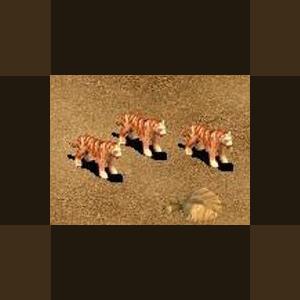About This File
The Caspian tiger or Persian tiger (Panthera tigris virgata) was the westernmost subspecies of tiger.
Found in Iran, Iraq, Afghanistan, Turkey, Mongolia, Kazakhstan, Caucasus, Tajikistan, Turkmenistan and Uzbekistan until it apparently became extinct in the late 1950s, though there have been several alleged sightings of the tiger.When extant, the Caspian tiger was the third largest of the known subspecies of tigers. The body of this subspecies was quite stocky and elongated with strong legs, large, wide paws, and unusually large claws. The ears were short and small, and gave the appearance of being without hair on the tips. Around the cheeks, the Caspian tiger was generously furred and the rest of its fur was long and thick. The coloration resembled that of the Bengal Tiger. The skin specimen in the British Museum has a yellow-gold color over the back and flanks, while the sides of the body are lighter than the back and the striping also varies from light to dark brown. The chest and abdomen is white with yellow stripes, while the facial area is yellow with brown stripes on the forehead and obvious white patches around the eyes and cheeks. Outer portions of the legs are yellow and the inner areas white. The tail of this subspecies is yellow and has yellowish white stripes. In winter, the hair of the Caspian tiger was very long, and the tiger had a well-developed belly mane and a short nape mane. Male Caspian tigers were very large and weighed 169-240 kg. Females were not as large, weighing 85-135 kg.
Work with the preserved remains of the Caspian tiger has shown that it shares a comparatively recent common history with the Siberian tiger (P. t. altaica), at least when it comes to maternal or mitochondrial lineages. It appears that tigers colonized Central Asia at most 10,000 years ago, and the modern Siberian stock may be the result of a few Caspian tigers subsequently wandering east via North Asia.
Until the 19th century, Caspian tigers still inhabited wide spaces of Western and Central Asia. In the mid-1800s, Caspian tigers were killed 180 km northeast of Atbasar, Kazakhstan and near Barnaul, Russia (Ognev 1935, Mazák 1981). The only reported Caspian tiger from Iraq was killed near Mosul in 1887 (Kock 1990). In 1899, the last Caspian tiger near the Lop Nur basin in Xinjiang, China, was killed (Ognev 1935). Caspian tigers disappeared from the Tarim River basin in Xinjiang, China, by the 1920s. (Nowell & Jackson 1996) In 1922, the last known tiger in the Caucasus region was killed near Tbilisi, Georgia, after killing domestic livestock (Ognev 1935). The last record of the Caspian tiger on the Ili River, their last stronghold in the region of Lake Balkhash, Kazakhstan, dates to 1948. (Nowell & Jackson 1996)
The Russian government had worked heavily to eradicate the Caspian tiger during planning a huge land reclamation program in the beginning of the 20th century. They considered there was no room for the tiger in their plans and so instructed the Russian army to exterminate all tigers found around the area of the Caspian Sea, a project that was carried out very efficiently. Once the extermination of the Caspian tiger was almost complete, the farmers cleared forests and planted crops like rice and cotton. Due to intensive hunting and deforestation, the Caspian tiger retreated first from the lush lowlands to the forested ranges, then to the marshes around some of the larger rivers, and finally, deeper into the mountains, until it almost certainly became extinct. The last stronghold of the Caspian tiger in the former Soviet Union was in the Tigrovaya Balka area, which is situated in Tajikistan in the undercurrent of Vakhsh River between the Piandj and Kafirnighan at the board of Afghanistan. Though the tigers were reported as being found here until the mid-1950s, the reliability of these claims is unknown.
Updated 2010-10-30
Just to save space with less in zip and smaller image.
Nothing new.



Recommended Comments
There are no comments to display.
Create an account or sign in to comment
You need to be a member in order to leave a comment
Create an account
Sign up for a new account in our community. It's easy!
Register a new accountSign in
Already have an account? Sign in here.
Sign In Now